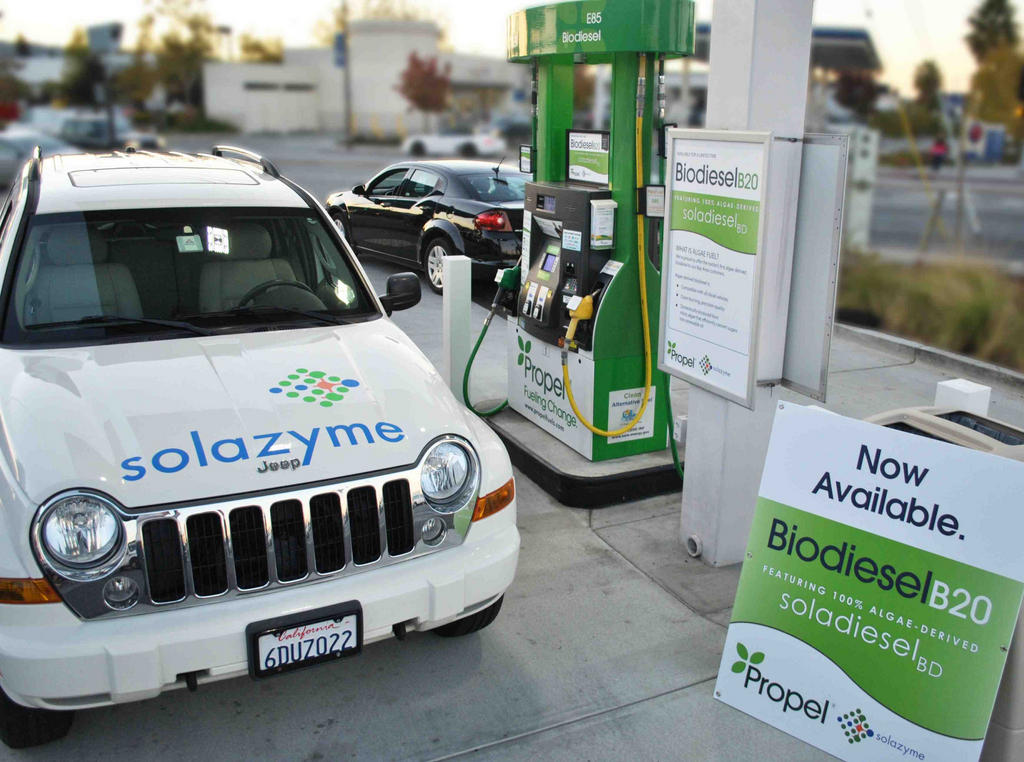A lot of activities going on with Solazyme that includes its third quarter earnings report yesterday, the launch of its algal-based diesel to the consumer market, expansion of its production capacity in Brazil through the Bunge joint venture, and finally, a partnership with Archer Daniels Midland (ADM) for additional production capacity through ADM’s Clinton, Iowa, fermentation plant — the same plant where Metabolix previously produce its polyhydroxyalkanoate or PHA bioplastic resins before ADM decided to drop Metabolix in January this year.
Let’s first talk about Solazyme’s new partnership with ADM (I can imagine the Metabolix people wincing on this news…). Come to think of it, it does makes sense for Solazyme to partner with ADM as the company is one of the biggest (if not the biggest) triglyceride oils producer and distributor worldwide. They can definitely learn from ADM how to market their own algal oils within the industrial and nutritional/food markets.
Solazyme announced yesterday that it will collaborate with ADM to manufacture its algal oils in Clinton, with initial capacity of 20,000 tonnes/year expected to start in early 2014. The company plans to increase production to 100,000 tonnes/year in subsequent years.
ADM’s wet mill adjacent to the fermentation plant will initially provide dextrose for the fermentation (Solazyme’s algae feeds on sugar to produce oils). Steam and power will also be delivered from ADM’s cogeneration facility that is partially fired with renewable biomass.
A great bonus for Solazyme is that it will only take minor retrofitting and permits before the plant can start production in 2014. That means it does not have to spend large capital to get a facility up and running. I do wonder how much they’re paying ADM to use the facility and source dextrose?
According to the earnings conference call, Solazyme has sole ownership of revenues and cash flow from oil production in the Clinton facility after some net payments to ADM for their services. The deal with ADM also includes market developments that gives Solazyme access to ADM’s R&D and application resources.
You can check out the company’s third quarter earnings presentation below.
[slideshare id=15184916&doc=solazymeq32012-121114231043-phpapp02]
Oh and one thing to note on the ADM deal, Solazyme said it will have the option to make certain payments to ADM via stock instead of cash.
Solazyme is very confident of current and future demand for its algal oils that it is also expanding its target production capacity in its Moema, Brazil, facility currently being built from 100,000 tonnes/year to 300,000 tpy via its joint venture with US agribusiness firm Bunge (a major competitor of ADM).
The Brazil facility with initial capacity of 100,000 tonnes/year is said to be still on schedule for startup in 4Q 2013 and the expansion to 300,000 tonnes is expected by 2016. The JV (called Solazyme Bunge Produtos Renováveis Ltda.) will also include marketing Bunge’s distribution network to market Solazyme’s algal oils for food application in Brazil.
According to Solazyme, at least 75% of the capacity in Moema facility coming in will be for industrials and chemicals, and 25% or less will be in fuels. I’m not sure if that ratio will change as the company looks at food applications opportunity. Solazyme did mention that a potential for another facility somewhere other than in Moema could happen under the Bunge JV.
Cost estimate for the Moema plant was previously estimated between $90m-$110m to build.
The blog just wanted to mention that Solazyme is currently producing its algal oils in its newly started Peoria, Illinois, facility which has a nameplate capacity of 2m liters/year of oil (around 1,820 tonnes/year). Most of the oils produced here are for demonstration purposes although Solazyme is already using its oils in personal care products through its Algenist brand being sold in Sephora and TV shopping channel QVC.
Solazyme also announced on Tuesday its month-long pilot program with biofuel retailer Propel Fuels where the companies are now selling Solazyme’s algae-based diesel (called Soladiesel BD) in California at Propel’s retail pumps in Redwood City, San Jose, Berkeley, and Oakland.
The fuel (composed of 20% blend Soladiesel BD) is being sold at the same price as conventional diesel fuels. The algae-based diesel reportedly meets or exceeds ASTM quality specifications, has shown performance enhancements including cold temperature operating performance, and is compatible with existing diesel engines.
According to Solazyme, the program is more on showing proof of concept that their algae-based diesel works rather than getting profit out of it.
This is good as there had been reports lately doubting the commercial viability of algae-based biofuels. You can check out this recent report from the National Research Council, which stated that scaling up production of algae-based biofuels to meet at least 5% (or 39bn liters) or US transportation fuel needs would mean unsustainable demands on energy, water and nutrients.
The report covered different production pathways for algal biofuels such as growing selected algae strains in open ponds or closed photobiorectors using various water sources; collecting and extracting oil from algae; or collecting fuel precursors secreted by algae and then processing the oil into fuel (such as what Solazyme has).
The report noted that to produce the amount of algal biofuel equivalent to 1 liter of gasoline, between 3.15 liters to 3,650 liters of freshwater is required, depending on the production pathway. Fortunately for Solazyme, they are not into using algal growth ponds.
For algal biofuels to contribute a significant amount of fuels for transportation in the future, the report suggested that research and development would be needed to improve algal strains, companies need to test additional strains for desired characteristics, advance the materials and methods for growing and processing algae into fuels, and reduce the energy requirements for multiple stages of production.
By the way, the National Algae Association disputed this report with a recent statement that this study is out-dated, inaccurate and has incomplete information provided by the Department of Energy’s Biomass Program.
“The Department of Energy’s 2010 National Algal Biofuels Technology Roadmap proved that the land area needed for algae was diminimus compared to the land mass requirements to grow other feedstocks for other alternate fuel products such as corn and soy; we have proven that the land mass requirements for enclosed vertical systems is significantly less than for the raceway ponds. We have also learned there is a huge learning curve between growing algae in a lab and growing, harvesting and extracting commercially on acreage and/or inside buildings.” – NAA
And before I end this post, I just wanted to add other recent news from the algae community such as Sapphire Energy collaborating with Institute for Systems Biology (ISB) to further their research on commercial-scale algae biofuel production, and start-up firm Algix LLC that is developing algae-based bioplastic.
A little bit information on Algix as their website seems to be down right now, is that the company was founded in 2010 using technology developed in collaboration with Kimberly Clark and the University of Georgia. According to a recent article from Biomass magazine, Algix has officially entered the commercial packaging industry as the company will soon provide algae-based resins to Dordan Manufacturing located in Illinois.
Algix is said to have developed a method in growing its algae using wastewater from carpet mills. The algae is then formed into a powder and combined with other resins. Dordan will reportedly use the bioresins in thermoformed packaging options like clamshells, trays or other packaging components.
This reminds me of Cereplast’s algae bioplastic (under the trademark Cereplast Bio-polyolefins® formerly named Cereplast Hybrid Resins®) which is composed of blends of algae with non-food grade industrial starch and polypropylene.





One response to “Algae update: Solazyme et al.”
[…] plant). But I have my doubts about even that. Various message boards dedicated to biofuels like here and here indicate Solazyme’s Peoria facility is being used as more of a demonstration […]